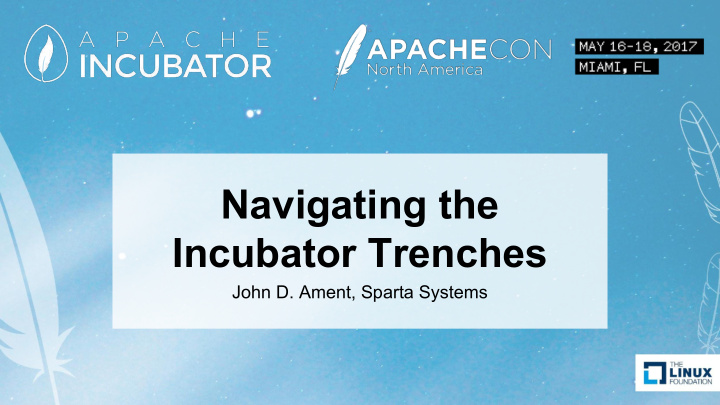



Navigating the Incubator Trenches John D. Ament, Sparta Systems
Who am I? http://twitter.com/johnament | http://github.com/johnament Apache DeltaSpike PMC - it’s how I got started! Active in the Incubator - how I learned The Apache Way Other ASF projects - ActiveMQ, Usergrid, Juneau, Tamaya, Aria Tosca, Pony Mail Outside the ASF - Arquillian, Hammock
How to get these slides? https://s.apache.org/jda_acna_2017
What is the Incubator? •Where you (as a community) go to learn The Apache Way •The main entry point for new projects •The ASF does accept new Straight-to-TLP projects • Sometimes.. •This is for everything else
Why Come to the ASF? •Open development community •Move away from vendor driven development •Strengthen an existing community
Why Incubate? •You're unsure of the ASF's policies and need to learn them more •You’re looking to learn The Apache Way •You need to prove out your community growth •You’re unsure of the actual licensing stance of your project
How to Incubate •Find a Champion, someone who will answer your questions on a personal basis •Draft a Proposal, giving good details about the project and why you think its suitable • Your Champion will help you draft the proposal •Find Mentors, who will help guide the podling into maturing • Hopefully your Champion is your first Mentor
Discuss & Vote •Your discussion thread will lead to finding more potential contributors and mentors • Be selective •Hold your first vote! • Someone from the incoming project should start the vote • Sometimes the Champion does it
Acceptance •Once the incubator has approved you to join, its time to get started at Apache • This is the time when you can start calling yourselves “Apache Foo” •The Champion’s role is done • We hope they’re a mentor still •Mentors should start helping with Podling Bootstrap
Migrating Development Over •E-mail, e-mail, e-mail! •Use our JIRA, or BugZilla •GitHub is OK, with prior approval • If you’re using GitHub, may make sense to use GitHub Issues
Keeping Your Source Code Clean •Start with a grant, ideally •If you're an existing open source project, may not be needed •Ideally, we want a consistent code base with appropriately licensed code
Grants & IP Clearance •Either provide a software grant for the ASF to use the code •Or go through IP Clearance to vet the code
Watch What you Import •Always credit the original author •Prefer transitive dependencies
Build a Community •Open discussions get more people participating •E-mail avoids “the loudest voice” •It also helps with asynchronous processing - ensuring that your diverse community can be located anywhere in the world
Dependencies • Take a close look at what licenses are approved, and what are banned • If you don't see what you're using, don't assume, ask!
Getting a Release Out the Door •Get in the habit of frequent releases •Releases should get better each go around, fixing common license and notice content issues
Release Contents •Apache produces Source Code Releases •Convenience binaries can be published in addition to the source code
Naming Your Release •The most common is "apache"-"podling"-"version"-"incubating" •Incubating isn't part of the version
What goes in it? •All of your source code •Everything required to build it •Don't include binaries in the source release
Stick Around for Justin's talk in a few minutes about Incubator Releases!
Recommend
More recommend